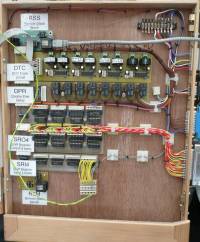Hysteresis Loop - The RPC Control Box
Overview
Here we have the box containing the RPC modules that control the hysteresis loop demonstration.
 At the top, connected to a grey Cat5 cable coming in from the right is a RSS (Remote Stack Slave), moving down the 'Stack' we have next a DTC (DCC Track Circuit) this provides the track occupation feedback. This module replaces the original FTC (Floating Track Circuit) used previously, the loose connector provided the 'Bias voltages' required. Next there is a DPR (Double Pole Relay) module, the demo was originally designed for DC operation and this board controls power feed to the track, in DCC mode all relays are switched on so power is fed to all track sections. Next there are two SRO4 (Shift Register Output x 4 bytes) modules, the first is very sparsely populated, the two orange wires control the point motor drivers and the blue one controls the 'feather' on the first signal. The second SRO4 is fully populated and these wires go to the 8 four aspect signals. The last module used in this configuration is the SRI4 (Shift Register Input x 4 byte) module, this again is sparsely populated, having just two grey wires from the switches mounted on the point motors, these provide the point position feedback. The connector with the grey wires would normally be connected directly to the module, the breakout arrangement here was to allow the point position to be fed to a separate demonstration, as was the ribbon cable connected to the DTC. Lastly on this stack is a RSM (Remote Stack Master), not used here.
At the top, connected to a grey Cat5 cable coming in from the right is a RSS (Remote Stack Slave), moving down the 'Stack' we have next a DTC (DCC Track Circuit) this provides the track occupation feedback. This module replaces the original FTC (Floating Track Circuit) used previously, the loose connector provided the 'Bias voltages' required. Next there is a DPR (Double Pole Relay) module, the demo was originally designed for DC operation and this board controls power feed to the track, in DCC mode all relays are switched on so power is fed to all track sections. Next there are two SRO4 (Shift Register Output x 4 bytes) modules, the first is very sparsely populated, the two orange wires control the point motor drivers and the blue one controls the 'feather' on the first signal. The second SRO4 is fully populated and these wires go to the 8 four aspect signals. The last module used in this configuration is the SRI4 (Shift Register Input x 4 byte) module, this again is sparsely populated, having just two grey wires from the switches mounted on the point motors, these provide the point position feedback. The connector with the grey wires would normally be connected directly to the module, the breakout arrangement here was to allow the point position to be fed to a separate demonstration, as was the ribbon cable connected to the DTC. Lastly on this stack is a RSM (Remote Stack Master), not used here.
DTC
DTC (Dcc Track Circuit) as the name suggests is suitable for DCC only. One side of the Track Power supply is passed through a current transformer, when the track is occupied by a loco or stock fitted with resistors across the wheels, the resulting current is detected and an occupied status results on the module output(s). This module, MERG Kit 56*, has 8 such detectors and is arranged such that the board may be separated into 4 self contained pairs.
*Kit 56 in its original design has been discontinued and replaced by Kit 56A, this of square format with 4 sensor circuits on 2 sides and the output connector in the centre. This cannot be divided up as the original and so a new kit (Kit 50 DTC2) has been designed to fill this need.
FTC
FTC (Floating Track Circuit) is suitable for both DC and DCC track power, the detection is of the diode drop variety. The term Floating in its title refers to the fact that the power supply does not have to be tied to the track power. Although there is a 'common return' connection required, this is of high impedance.
DPR
DPR (Double Pole Relay) module contains 8 double pole changeover relays. QPR (Quad Pole Relay) has 8 x 4 pole changeover relays.
SRO4
SRO4 (Shift Register Output x 4 bytes) provides 32 open collector outputs.
SRI4
SRI4 (Shift Register Input x 4 bytes) provides 32 active low inputs.
RSE
Remote Stack Extension, comes in two parts, a RSM (Remote Stack Master) and RSS (Remote Stack Slave). The RSM plugs onto the stack that is to be extended, it derives its power from the stack and drives the outgoing Data, Clock and Strobe lines down a cat 5 cable and receives the incoming data in the same way. At the other end of the cable is the RSS, this has a voltage regulator which allows it to power the additional stack modules connected to it. It has three receivers for the Data, Clock and Strobe and a driver for the return Data.